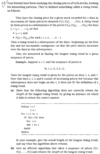Exam Flashcards
(92 cards)
1
Q

A

2
Q

A

3
Q

A

4
Q

A
- Run the jobs in decreasing order of finishing time f_i

5
Q

A

6
Q

A

7
Q

A

8
Q

A

9
Q
Exchange argument
A
- Does not decrease optimality
- e.g, in EEF, it still contains an disjoint set of intervals when exchanging the leftmost intervals from set O (optimal set) and A (algorithm set)
10
Q

A

11
Q

A

12
Q

A

13
Q

A

14
Q

A

15
Q

A

16
Q

A

17
Q

A

18
Q

A

19
Q

A

20
Q

A

21
Q

A

22
Q

A

23
Q

A

24
Q

A

25

26

* Show how to swap
* In case of interval scheduling, swap the two leftmost solutions from optimal and algorithms
* Show how the swap doesnt decrease optimality
* In case of interval scheduling, since the interval has EEF, this does not intersect other intervals in the optimal set, hence its also an optimal solution
27


28


29


30


31


32


33


34


35


36


37


38


39


40


41


42


43


44


45


46


47


48


49


50


51


52


53


54


55


56


57


58


59


60


61


62


63
OPT(j)= max(v\_j + OPT(P(j)), OPT(j -1))
we define PU), for an interval j, to be the
largest index i \< j such that intervals i and j are disjoint

64
# Definitions
Give definition of Dynamic programming
* Solve problem by solving sub instance of problem
For a given instance of a problem, we consider certain sub-instances
that grow incrementally. For each of these sub-instances it suffices to keep one optimal solution (because, by an exchange argument, no other solution can lead to a better final solution for the entire instance). The optimal values are then computed step by step on the growing sub-instances. A “recursive” formula specifies how to compute the optimal value from the previously computed optimal values for smaller sub-instances. However, it is not applied recursively, rather, the values are stored in an array, and calculations happen in a for-loop.
65
What are the topics in the course
1. Time complexity, O Notation
2. Greedy
3. Dynamic programming
4. Searching, divide and conquer
5. Reduction, NP completness
6. DAG's and graph properties
66
Give *stay ahead* argument for Interval scheduling
Algorithm has the option to choose candidate j\_r as its solution

67
Types of greedy problem
* Picking out a subset (interval scheduling)
* Then use exchange argument
* Give an ordering
* Use “swapping” argument where you swap the order of the elements
68
Unroll the following recurrence 2T(n/2) + O(n)

69
What are some characteristics of algorithms
* Looping
* Looping through the whole input, O(n) complexity
* No looping in algorithm refers to constant time i.e, O(1)
* Elementary operations
* Arithemtic operations
* If conditions - adding/mdulitplication, querying etc… indexing
* Indexing/querying database or array
70


71


72


73


74


75


76


77


78


79


80


81


82


83


84


85


86


87


88


89


90


91


92




